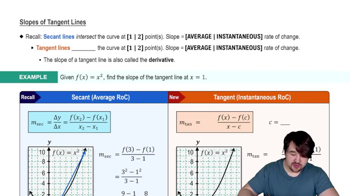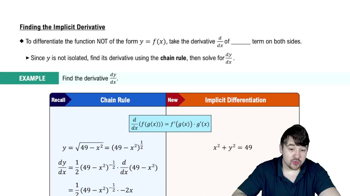Table of contents
- 0. Functions7h 52m
- Introduction to Functions16m
- Piecewise Functions10m
- Properties of Functions9m
- Common Functions1h 8m
- Transformations5m
- Combining Functions27m
- Exponent rules32m
- Exponential Functions28m
- Logarithmic Functions24m
- Properties of Logarithms34m
- Exponential & Logarithmic Equations35m
- Introduction to Trigonometric Functions38m
- Graphs of Trigonometric Functions44m
- Trigonometric Identities47m
- Inverse Trigonometric Functions48m
- 1. Limits and Continuity2h 2m
- 2. Intro to Derivatives1h 33m
- 3. Techniques of Differentiation3h 18m
- 4. Applications of Derivatives2h 38m
- 5. Graphical Applications of Derivatives6h 2m
- 6. Derivatives of Inverse, Exponential, & Logarithmic Functions2h 37m
- 7. Antiderivatives & Indefinite Integrals1h 26m
- 8. Definite Integrals4h 44m
- 9. Graphical Applications of Integrals2h 27m
- 10. Physics Applications of Integrals 2h 22m
4. Applications of Derivatives
Implicit Differentiation
Problem 3.8.65b
Textbook Question
Vertical tangent lines
b. Does the curve have any horizontal tangent lines? Explain.
 Verified step by step guidance
Verified step by step guidance1
To determine if the curve has any horizontal tangent lines, we need to find the derivative of the function that defines the curve. The derivative will give us the slope of the tangent line at any point on the curve.
Set the derivative equal to zero and solve for the variable. This is because a horizontal tangent line has a slope of zero.
Identify the points on the curve where the derivative is zero. These points are where the curve may have horizontal tangent lines.
Verify if these points are indeed on the curve by substituting them back into the original equation of the curve.
Discuss the behavior of the curve at these points to confirm if they correspond to horizontal tangent lines, considering the context of the problem and any constraints given.
 Verified video answer for a similar problem:
Verified video answer for a similar problem:This video solution was recommended by our tutors as helpful for the problem above
Video duration:
3mPlay a video:
Was this helpful?
Key Concepts
Here are the essential concepts you must grasp in order to answer the question correctly.
Tangent Lines
Tangent lines are straight lines that touch a curve at a single point without crossing it. The slope of the tangent line at a point on the curve represents the instantaneous rate of change of the function at that point. Understanding tangent lines is crucial for analyzing the behavior of curves, particularly in determining where they are increasing or decreasing.
Recommended video:

Slopes of Tangent Lines
Vertical Tangent Lines
A vertical tangent line occurs when the slope of the tangent approaches infinity, which typically happens when the derivative of the function is undefined at that point. This indicates that the curve is steeply increasing or decreasing, and it can signify a cusp or a vertical asymptote. Identifying vertical tangents helps in understanding the nature of the curve's behavior at specific points.
Recommended video:

Slopes of Tangent Lines
Horizontal Tangent Lines
A horizontal tangent line occurs when the slope of the tangent line is zero, indicating that the function has a local maximum or minimum at that point. This means that the rate of change of the function is momentarily flat, and it is essential for finding critical points in optimization problems. Analyzing horizontal tangents is key to understanding the overall shape and turning points of a curve.
Recommended video:

Slopes of Tangent Lines

 5:14m
5:14mWatch next
Master Finding The Implicit Derivative with a bite sized video explanation from Nick
Start learningRelated Videos
Related Practice



